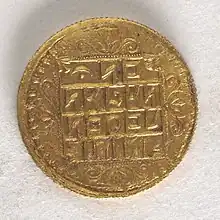
Koch coinage or Coins of Koch dynasty, originally called Narayani Mudra, were issued from 1555 to 1866 under the Koch Kingdom. It was first introduced by the Koch king Nara Narayan (r. 1544–1587)[1] in the year of his accession in 1555 A.D or Saka 1477. Both gold and silver coins were impressed. These Narayani coins prevailed over other neighboring kingdoms of Northeast India and North Bengal during this period. Narayani coins were also the medium of trade in some northeastern kingdoms and tribal chiefdoms with Northeast Asia. From 1866, onwards the circulation of Narayani coins was ceased by the British government. However on a few instances after 1866, commemorative coins were impressed for the Raja of Cooch Behar on the day of his ascendancy.

The term "Narayani coins" is derived from the name Nara Narayan (1554–1587) the last ruler of the undivided Koch dynasty but according to other sources, the term might be derived from Narayan, the royal deity of the Koch kings.[2] Raghudeva, the son of Chilarai who assumed his full independence over the area between the Sankosh river and the Bhareli river that came to known as Koch Hajo struck his own coins. However, this independence was short lived but the area west of the Sankosh River known as Koch Behar remained in existence until 1949 and continued issuing coins till very late.[3]
Notes
- ↑ "Gunabhiram Barua mentioned in 'Assam Burunji' that the Cooch Kingdom had no coin before Maharaja Biswa Singha. After the accession on the throne, Maharaja Biswa Singha printed 'Sikka Rupee'. But none of these have been discovered till now."(Haque 2019:632)
- ↑ (Haque 2019:631–634)
- ↑ (Shamoon:524)
References
- Haque, Md.Jahirul (2019). Origin, Expansion and Abolition of Narayani Coins of the Princely state of Cooch Behar. International Journal of Advanced Research. p. 631–634.
- Shamoon, Ahmad. "Coins of the Kings of Koch Bihār in Koch Bihar Palace Museum". Indian Journal of Archaeology.
- Dutta, Debajit (2015). Koch coinage a study in historical perspective.